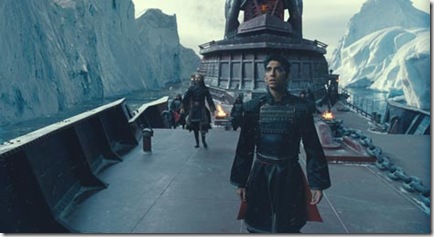The question is this: how does one adapt over four hundred minutes of story from twenty episodes of an excellent animated series into a one hundred-minute movie? The answer is, apparently, not very well. A slightly less pressing question might be: why did anyone think a hastily applied 3D conversion would help this muddled excuse for a fantasy epic in any conceivable way? That one I couldn’t tell you.
The animated series, The Last Airbender, is a sixty-one episode epic that is filled with life and energy; drama and humor; wit and style. M. Night Shyamalan’s film covers events from the first twenty episodes. Where the series has time to develop, let’s say, Sokka [played in the film by Jackson Rathbone] from a ineffectual buffoon into a competent, reasonably mature character, the film doesn’t have time to do so and, thus, barely touches on Sokka at all.
The concept of the series is that there are four mystical, elemental abilities that are tied to four powerful groups [Air Nomads, Water Nation, Earth Nation and Fire Nation] – and that the lord of the Fire Nation has decided to conquer the world. The only force powerful enough to stop him is the Avatar – born into each generation as a member of a different Nation, following a specific cycle. Thus the fire Lord knows the next Avatar will be born into an Air Nomad and has all of them exterminated.
This is just background, which is layered into the series through the episode’s opening credits and deftly placed moments of exposition throughout the first several episodes. In the film, this is revealed by long, awkward speeches and clumsy transitions between equally awkward and uninspiring action sequences.
The film opens, as does the series, with the discovery of a boy in a bubble of ice by the aforementioned Sokka and his sister, Katara [Nicola Peltz, who reminds of Kristin Kreuk]. The boy’s name is Aang [Noah Ringer] and he is tattooed in the manner of the Air Nomads – the last of whom was though to have been slain a century ago.
From this point on, Shyamalan switches back and forth between action scenes and expository dialogue that is so far from adequate that the film feels like a series of starts and stops. His introduction of the Fire Lord’s son, Prince Zuko [Dev Patel] is, again, awkward – and his exploration of Zuko’s motivation, clumsy. At this point, I noticed my brother checking his watch. The movie wasn’t fifteen minutes in.
As a series, The Last Airbender presented viewers of all ages with a sophisticated blend of action, character study, adventure and even the metaphysical struggle between darkness and light. As a film, The Last Airbender attempts – and fails – to do all these things… with the added benefit of a 3D conversion that is not only superfluous, but spectacularly effective in producing headaches and dizziness [and I not talking about its effects on epileptics – I’m talking about the headache that required serious painkillers before I could write this review] – and further muddying less than adequate CG effects.
To be completely fair, I have to add that there is one very successful scene that occurs during the third act. It’s a three-hankie moment – and the only one that doesn’t feel labored, forced, awkward or false. It’s too bad that the rest of The Last Airbender couldn’t match it. There will be no Book Two. Trust me.
Final Grade: D

